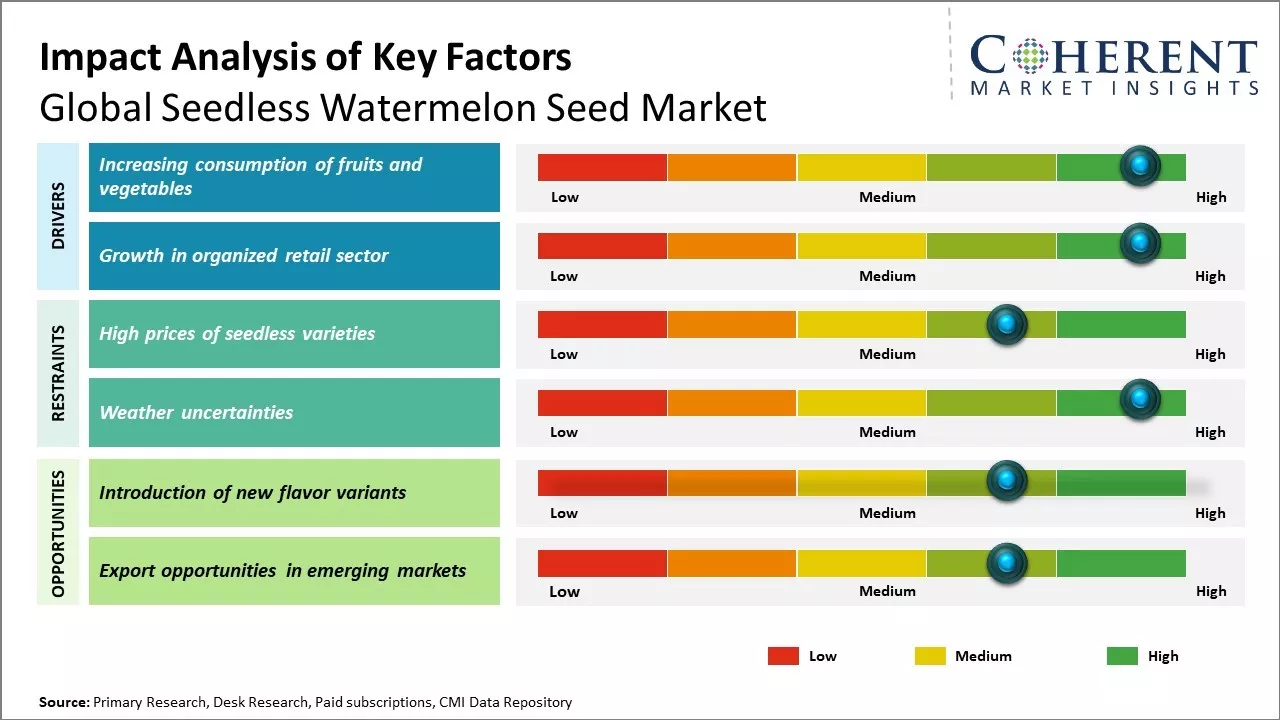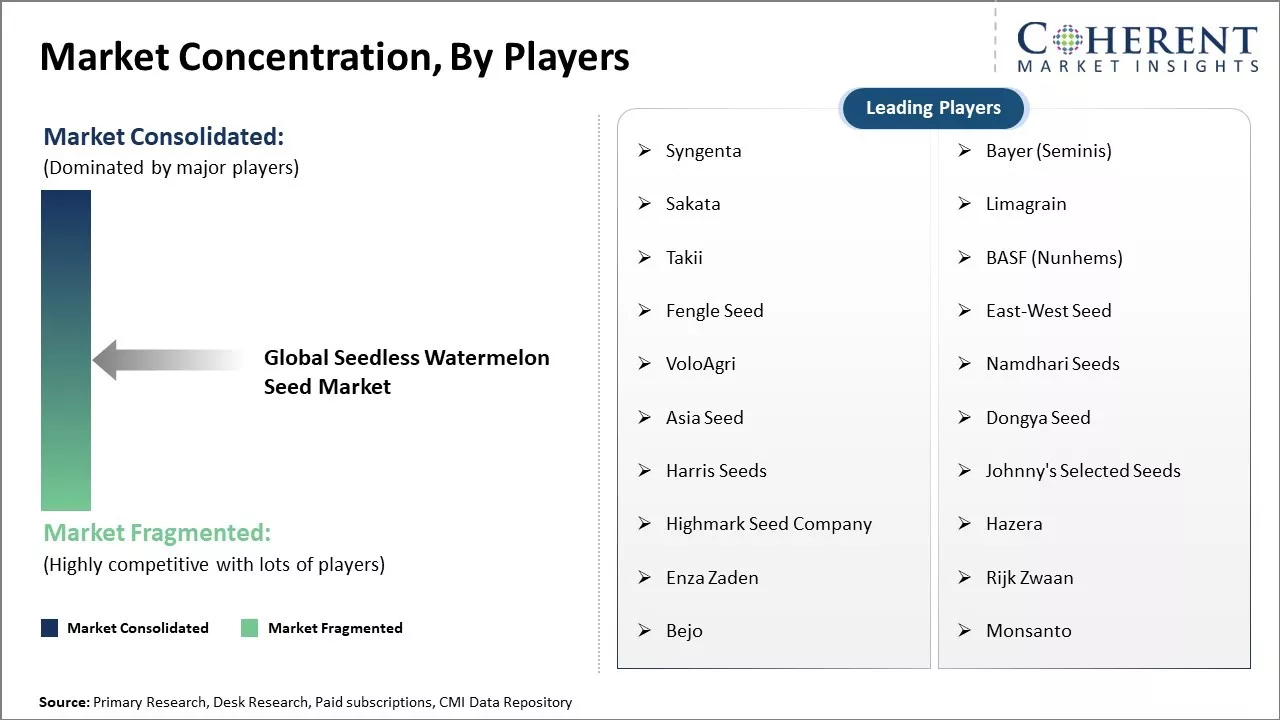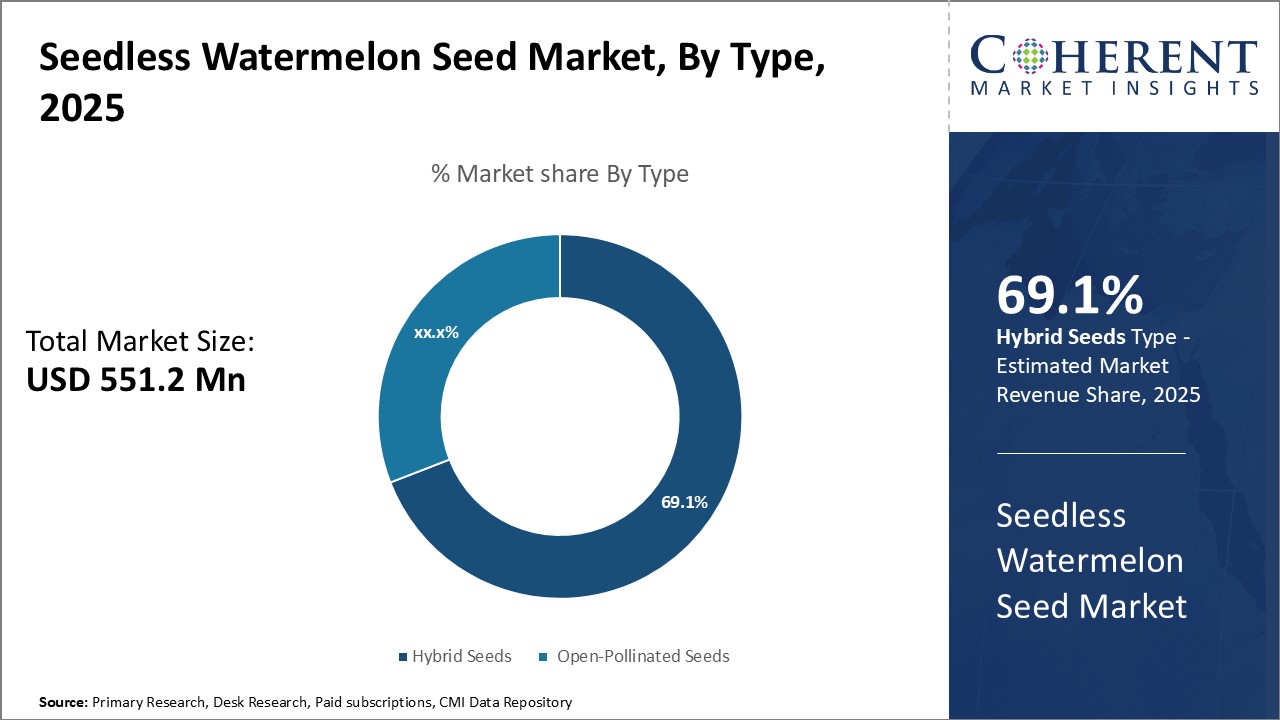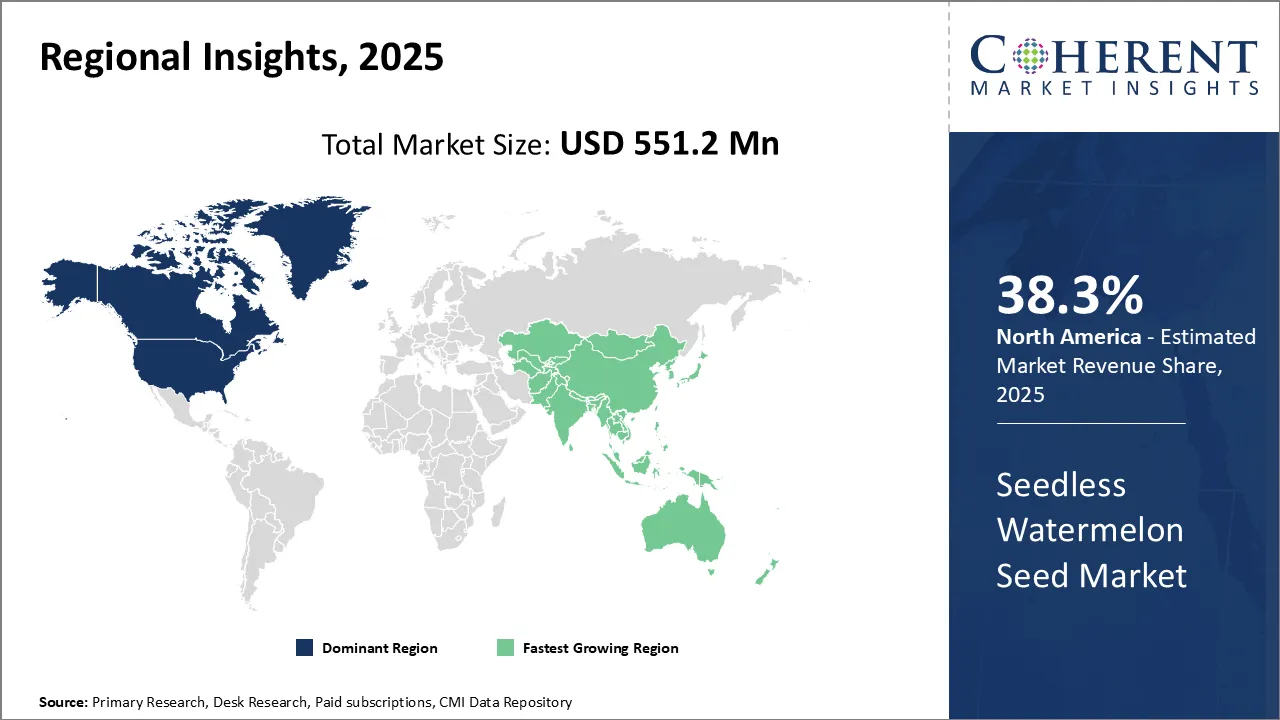Seedless Watermelon Seed Market Size and Trends
Global seedless watermelon seed market is estimated to be valued at USD 551.2 Mn in 2025 and is expected to reach USD 818.4 Mn by 2032, exhibiting a compound annual growth rate (CAGR) of 5.8% from 2025 to 2032.

Discover market dynamics shaping the industry: Download Free Sample
Global seedless watermelon seed market growth is driven by increasing demand for seedless watermelons across various regions. Consumers prefer seedless watermelons as these are more convenient to eat and taste better than seeded varieties. Moreover, seedless watermelons command higher prices in the market as compared to regular seeded types. Major producers worldwide are focusing on developing new hybrid varieties of seedless watermelons through advanced breeding techniques to cater to the growing demand for seedless watermelon seed. Ease of cultivation and higher yields associated with seedless watermelons encourages more farmers to shift from conventional varieties. The seedless watermelon seed market growth is driven by rising consumption of seedless watermelons and increasing investments in agricultural innovation.
Market Driver - Increasing consumption of fruits and vegetables
Global consumption pattern of fruits and vegetables is changing rapidly over the past few decades. People are becoming more health conscious and aware of the importance of a balanced diet in their daily life. Medical experts and health organizations around the world have been consistently recommending higher intake of fruits and vegetables to maintain overall wellness and reduce risks of many lifestyle diseases. As disposable income increases, people are willing to spend more on nutrition-rich food items like watermelon, which is an excellent source of vitamins and nutrients. For example, China has experienced significant growth in disposable incomes due to rapid economic development and urbanization. According to the data published by National Bureau of Statistics of China in 2020, the average annual disposable income per capita in China reached US$ 4524.49 in 2020, up from RMB 882.72in 2000, representing more than five-fold increase. Seedless varieties of watermelon are gaining popularity as these are hassle-free to eat compared to seeded varieties. The easily accessible flesh allows people to consume more quantity in short duration of time. There has been growing realization that fruits and vegetables must become an integral part of everyday diet for their proven health benefits. This increasing focus on dietary well-being has boosted demand for convenient and healthy snacking options like seedless watermelon internationally.
Market Concentration and Competitive Landscape

Get actionable strategies to beat competition: Download Free Sample
Growth in organized retail sector
The structure of food retail industry has transformed significantly across both developed and emerging markets. The dominance of traditional small grocery shops and wet markets has reduced considerably with rise of modern retailing formats. Supermarkets, hypermarkets, and convenience Stores are rapidly emerging in major urban centers worldwide as contemporary consumers increasingly seek a one-stop shopping experience. Organized food retail provides enormous opportunities to companies to market and distribute products effectively using modern merchandising techniques. This has opened up new sales avenues for innovative fruit and vegetable varieties like seedless watermelon. Strong supply chain and cold storage infrastructure of organized retailers ensure seamless delivery of perishables to consumers. Seedless watermelon gets better visibility on supermarket shelves as attractive packaging and product education helps it stand out. Moreover, price parity with regular watermelon varieties in retail outlets draws more impulse buyers. Market leaders such as Syngenta and other are partnering with retail majors for co- promotions and sampling activities to increase brand awareness and trial among shoppers. Thus, growth in surface retail enables seedless watermelon brands to enhance their reach as well as sales volumes rapidly.
Key Takeaways from Analyst:
North America dominates the market due to strong consumer demand for healthier and convenient snack options. Growing health awareness among consumers coupled with hectic lifestyles have increased the popularity of seedless watermelons in the region. Asia Pacific will emerge as the fastest growing market with China and India as major consumers. Expanding distribution channels and rising disposable incomes in developing nations can drive the market growth.
While demand for seedless watermelons rises significantly, high seed costs pose challenge to growers and farmers. Developing new seed varieties with higher fertility rates and productivity will be critical to lower seed prices over time. Weather uncertainties and disease outbreaks also pose threats to seed supply and grower profitability. However, technological advances in controlled-environment farming and widespread availability of seed treatment solutions can help mitigate weather-related risks.
Increasing focus on exports to countries in the Middle East and Europe with seedless watermelon deficit presents a major opportunity for key players. Favorable regulations supporting cross-border trade along with deployment of innovative cold chain logistics can further boost export potential. Investments in advanced farming techniques and partnerships across supply chain stakeholders.
Market Challenge - High prices of seedless varieties
Global seedless watermelon seed market growth can be hampered due to high prices of seedless varieties as compared to regular seeded varieties. Developing seedless varieties requires extensive research and development over several years along with patented seed technologies. This makes the production cost of seedless watermelon seeds significantly higher than conventional open-pollinated varieties. The high seed costs are eventually passed on to the farmers and consumers. Many small and marginal farmers in developing markets find it difficult to adopt seedless varieties due to their high upfront investment and switching costs. This price gap threatens to slow down the adoption of improved seedless cultivars. Seedless fruits also command a small premium over seeded varieties in retail markets, which limits their demand in price sensitive markets. The high seed and fruit costs need to be brought down through lower royalty rates, development of hybrid varieties with higher yields and more affordable seed production techniques to accelerate the growth of the seedless watermelon.
Market Opportunity - Introduction of new flavor variants
Global seedless watermelon seed market can witness growth opportunities through introduction of new and innovative flavor variants. While red-fleshed variations are the most common and popular worldwide, seed companies are investing in R&D to develop seedless watermelons with novel color, texture, size and flavor profiles. For example, introducing seedless varieties with yellow, orange or striped flesh could attract new consumers and drive incremental demand. Developing sweeter and more flavorful cultivars tailored to regional tastes could expand the customer base. Seed dealers are also focusing on dwarf cultivars ideal for urban agriculture and greenhouse production. Introducing novel flavors in seedless forms opens up untapped market potential by catering to changing consumer preferences for exotic and unique fruits. It helps boost repeat purchases and premiumization. With continued product innovation, seedless watermelons could increasingly disrupt the existing market dynamics.

Discover high revenue pocket segments and roadmap to it: Download Free Sample
Insights, By Type: Increased yield and desirable traits
In terms of type, hybrid seeds segment is estimated to contribute the highest market share of 69.1% in 2025. Hybrid seeds have become increasingly popular among seedless watermelon farmers due to their ability to produce higher yields as compared to open-pollinated varieties. Hybrids are created by crossing two inbred parent lines that exhibit desired characteristics like disease resistance, fruit size and shape, or taste. This hybrid vigor leads to watermelons with increased size, higher sugar content, and thicker outer rinds—all factors that improve marketability and profitability for farmers.
Many hybrid varieties have also been bred to withstand biotic and abiotic stressors better than traditional varieties. Many are resistant to common diseases like fusarium wilt and powdery mildew that can decimate open-pollinated crops. Their robust genetics allow them to maintain high yields even in less-than-ideal growing conditions with variable weather or soil quality. This resilience is appealing to farmers in regions with inconsistent or challenging climates.
Open-pollinated varieties can display more genetic variability, resulting in non-uniform ripening and cosmetic variations within the same crop. Hybrids bred through controlled crosses produce fruits that mature at the same rate and look nearly identical, meeting strict quality standards required by major buyers and supermarkets. This consistency and predictability benefits both farmers and consumers.
As seedless watermelon agriculture continues to industrialize and consolidate, hybrids have emerged as the predominant variety grown worldwide. Leading breeders like Seminis have developed market-leading hybrids optimized for yield, quality attributes, and mechanized production. Their popularity and advantages over other types ensure hybrid seeds remain the dominant segment.
Insights, By Distribution Channel: Expanded access and convenient options
By distribution channel, online retail segment is estimated to contribute the highest market share of 35% in 2025. During the COVID-19 pandemic, Amazon, an American multinational technology company, experienced significant growth in its online retail business. In 2020, the company reported a staggering 38% increase in net sales, reaching approximately US$ 386 billion as compared to 2019. Where farmers once primarily relied on local agricultural suppliers or seed companies' field representatives, internet commerce now provides a convenient new option for sourcing planting stock.
Through online retailers, farmers gain access to a much wider array of seed varieties from all over the world. These can research performance data, reviews from other growers, and compare multiple brands before choosing options best suited for their unique conditions. This level of information and choice was not previously possible through traditional brick-and-mortar channels alone.
The rise of e-commerce has also made hard-to-find specialty or new introductions much more accessible to any producer, regardless of their geographic location. Remote producers no longer need to travel long distances to procurement centers carrying specialized products. Seeds can now be reliably delivered straight to their farms.
Online shopping allows farmers to take advantage of competitive pricing and seasonal promotions only possible through online volume sales. While quality technical support is still provided through company field agents, the transactional component of the industry has largely shifted onto digital marketplaces where seeds can find their lowest prices. This transition online has driven significant business toward web-based distributors and remains the primarily growth area for seedless watermelon seed sales.
Regional Insights

Need a Different Region or Segment? Download Free Sample
North America dominates the global seedless watermelon seed market with an estimated market share of 38.3% in 2025. The large agricultural operations and advanced agricultural practices in countries like the U.S. have enabled mass production of seedless watermelon seeds. Leading seed companies in the region such as Monsanto, Syngenta and Bayer have established a strong foothold through extensive research and development. North American farmers have also optimally leveraged high-yielding hybrid varieties and efficient irrigation systems to achieve higher per acre seed production.
Stringent quality standards during packaging and export have helped North America seeds gain global acceptance. Most Latin American and European importers rely on the consistency offered by North American seeds. Prices of North American seeds are generally higher compared to other origins. However, farmers are willing to pay this premium because of the assured returns through higher yields and disease resistance. The region also benefits from its geographical proximity to major importers in Europe.
Asia Pacific region is expected to be the fastest growing market for seedless watermelon seed market. With rising population and increasing health consciousness, consumers are gravitating towards seedless watermelons due to their convenience and appealing taste. The demand for seedless watermelons is particularly strong in countries like China, India, and Japan. These nations not only have a rich agricultural history but are also investing in advanced agricultural technologies to improve crop yield and quality. The adoption of hybrid and genetically modified seedless varieties has been increasing, enhancing productivity and ensuring a consistent supply.
Market Report Scope
Seedless Watermelon Seed Market Report Coverage
| Report Coverage | Details | ||
|---|---|---|---|
| Base Year: | 2024 | Market Size in 2025: | USD 551.2 Mn |
| Historical Data for: | 2020 To 2024 | Forecast Period: | 2025 To 2032 |
| Forecast Period 2025 to 2032 CAGR: | 5.8% | 2032 Value Projection: | USD 818.4 Mn |
| Geographies covered: |
|
||
| Segments covered: |
|
||
| Companies covered: |
Syngenta, Bayer (Seminis), Sakata, Limagrain, Takii, BASF (Nunhems), Fengle Seed, East-West Seed, VoloAgri, Namdhari Seeds, Asia Seed, Dongya Seed, Harris Seeds, Johnny's Selected Seeds, Highmark Seed Company, Hazera, Enza Zaden, Rijk Zwaan, Bejo, and Monsanto |
||
| Growth Drivers: |
|
||
| Restraints & Challenges: |
|
||
Uncover macros and micros vetted on 75+ parameters: Get instant access to report
Market Segmentation
- Type Insights (Revenue, USD Mn, 2020 - 2032)
-
- Hybrid Seeds
- Open-Pollinated Seeds
- Distribution Channel Insights (Revenue, USD Mn, 2020 - 2032)
-
- Online Retail
- Offline Retail
- Direct Sales
- Regional Insights (Revenue, USD Mn, 2020 - 2032)
-
- North America
- U.S.
- Canada
- Latin America
- Brazil
- Argentina
- Mexico
- Rest of Latin America
- Europe
- Germany
- U.K.
- Spain
- France
- Italy
- Russia
- Rest of Europe
- Asia Pacific
- China
- India
- Japan
- Australia
- South Korea
- ASEAN
- Rest of Asia Pacific
- Middle East
- GCC Countries
- Israel
- Rest of Middle East
- Africa
- South Africa
- North Africa
- Central Africa
- North America
- Key Players Insights
- Syngenta
- Bayer (Seminis)
- Sakata
- Limagrain
- Takii
- BASF (Nunhems)
- Fengle Seed
- East-West Seed
- VoloAgri
- Namdhari Seeds
- Asia Seed
- Dongya Seed
- Harris Seeds
- Johnny's Selected Seeds
- Highmark Seed Company
- Hazera
- Enza Zaden
- Rijk Zwaan
- Bejo
- Monsanto
Share
Share
Missing comfort of reading report in your local language? Find your preferred language :
Transform your Strategy with Exclusive Trending Reports :
Frequently Asked Questions
EXISTING CLIENTELE
Joining thousands of companies around the world committed to making the Excellent Business Solutions.
View All Our Clients
